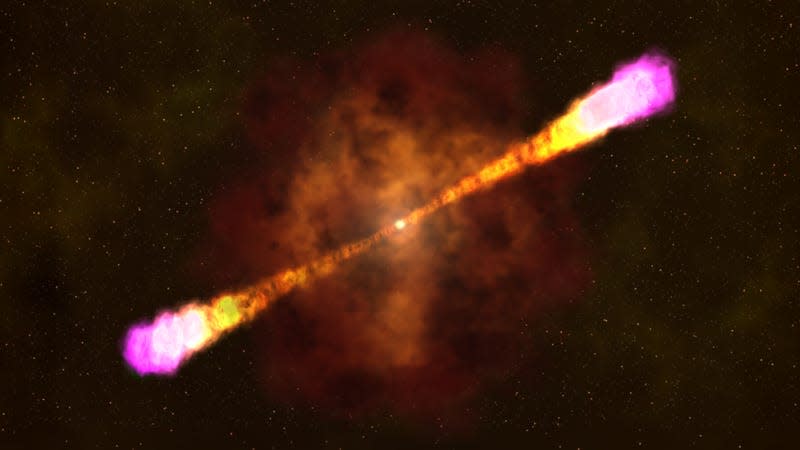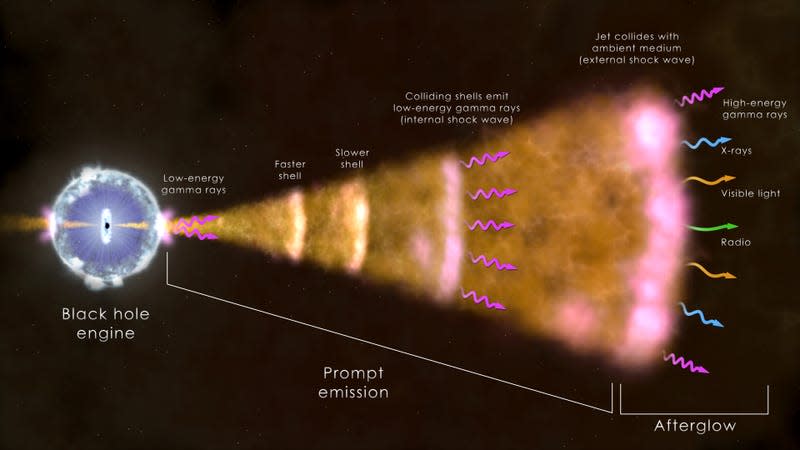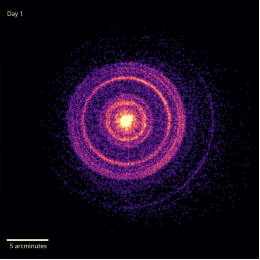Jet Streaming From the Brightest Known Gamma Ray Burst Is Weirder Than We Realized

Last October, astronomers witnessed a fleeting, extraordinarily bright gamma ray burst in the distant universe. Since dubbed the BOAT—the Brightest of All Time—a team of scientists has now reported an unusual structure to the gamma ray burst’s jet.
Gamma ray bursts are some of the universe’s largest fireworks shows. They’re tremendous explosions in the cosmos that emit—you guessed it—gamma rays, the most energetic type of electromagnetic radiation. They can be emitted by collapsing stars and mergers between them; basically, when massive objects interact, big “booms” occur.
Read more

The BOAT (officially named GRB 221009A) was about 70 times brighter than any previously recorded gamma ray burst. It occurred in a galaxy about 2 billion light-years from Earth; astronomers believe it to be a one-in-10,000-year event.
Today, researchers announced new details of the structure of the gamma ray’s jet—a huge plume of material spewed forth from the explosion’s source, thought to be a massive star collapsing into a black hole. Their research was published in Science Advances.

“For a long time, we have thought about jets as being shaped like ice cream cones,” said Alexander van der Horst, a physicist at George Washington University and a co-author of the study, in a university release. “However, some gamma-ray bursts in recent years, and in particular the work presented here, show that we need more complex models and detailed computer simulations of gamma-ray burst jets,” van der Horst added.
Jets of material accelerated to nearly the speed of light are par for the course for the universe’s massive objects. Quasars and pulsars both spew such jets, but the BOAT’s jets appear to have a shape that prolonged its glow, as seen from Earth-based observatories.
Brendan O’Connor, a graduate student at GWU and the study’s lead author, said in the same release that the BOAT could be the “Rosetta stone of long GRBs,” insofar as changing the way astrophysicists understand the jets spurted out by collapsing stars.
Long-duration gamma ray bursts are those that last more than two seconds; the BOAT lasted about 10 hours, according to ScienceNews. Longer bursts are generally associated with stellar deaths, while short-duration bursts are more often connected with stellar mergers and the formation of black holes, according to NASA.
Overview Animation of Gamma-ray Burst
Though the BOAT was extraordinarily bright, it’s not the largest explosion seen in space. Last month, astronomers announced the discovery of a multi-year explosion named AT2021lwx. They believe that explosion to be due to interactions between a black hole and a cloud of gas surrounding it.
More observations will certainly clarify the nature of the universe’s most roiling outbursts, as they have just helped astrophysicists discern aspects of the BOAT.
Future observatories—like the Vera Rubin Observatory in Chile—will help researchers image such outbursts the moment they appear, giving astrophysicists precious data on even the most fleeting events.
More: The World’s Largest Digital Camera Is Almost Ready to Look Back in Time
More from Gizmodo
Sign up for Gizmodo's Newsletter. For the latest news, Facebook, Twitter and Instagram.

